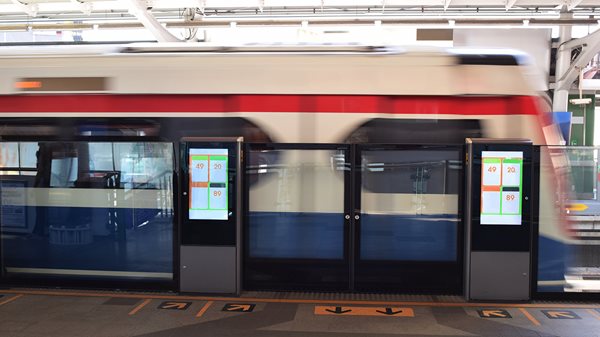数字标牌是一个充满活力、不断增长的市场,高速网络的发展、通信技术的改进以及数字标牌的参与和信息能力都为其提供了支持。该行业成功的关键在于解决速度、可靠性和安全性方面的挑战。
数字标牌行业面临的挑战 
数字标牌行业比乍看起来更加庞大和复杂。无论是从开发、部署、创意还是信息技术的角度来看,进入这一领域的人很快就会了解到,数字标牌解决方案有法规要求,而且必须高度安全。
此外,成本也是一个主要挑战,尤其是在分散安装的情况下。就数字标牌而言,计算运营和所有权成本非常复杂,因为它包括硬件、软件、连接、部署、管理应用程序、安全监控和一系列人员。
挑战和要求一览:
- 数字标牌供应商负责发布一些我们日常接触到的最面向公众的信息,如广告、旅游指南和重要公告,如黄色警报和天气警报。为了建立良好的声誉,供应商必须满足极高的可靠性标准,因为警报可能至关重要,而广告商花钱就是为了让人们看到。
- 安全至关重要,因为数据必须在管理应用程序和终端设备之间快速、安全地传输,不得篡改。例如,考虑到安全漏洞的可能性以及对机场和地铁广告牌或标牌上的信息和图像可能造成的令人尴尬的影响。
- 连接方法的成本和复杂程度各不相同,因此选择连接方法是最大的挑战之一。有线局域网安装每个标志每月可能要花费数百美元,而且一旦线路被切断就可能出现故障。而固定电话的安装可能需要数周或数月的时间。虽然 Wi-Fi 网络是一种经济有效的解决方案,但服务质量却不尽如人意。Wi-Fi 网络连接不可靠,特别是在人流量大的地方,使用超负荷会导致超时和断线。
选择合适的技术供应商可以大大缓解这些挑战,确保数字标牌部署战略的成功和成本效益。
数字标牌技术

就像汽车技术必须支持从客货车、赛车到商业送货车队等各种车辆一样,数字标牌背后的技术也必须支持大量的使用案例。例如,室内购物中心或机场标牌部署的需求与面临温度和湿度变化的室外标牌的需求大相径庭。
数字标牌技术注意事项一览:
- 硬件规格:用于路边建筑、城市户外空间和公交部署的标识解决方案必须坚固耐用,能够抵御振动和极端天气条件等环境因素。在室内环境中,即使在有墙壁和支柱等障碍物的密集建筑物中,它们也必须能够提供高质量的信号。
- 连接性:如今,连接数字标牌和支持通信系统的技术种类繁多,从多种类型的已安装基础设施到蜂窝电话,以及它们的多种组合。例如,有线线路可提供主连接,并可与有线或蜂窝网络进行故障切换。但由于上述挑战,以及蜂窝网络的改进和运营商成本的下降,蜂窝网络越来越多地成为主连接的选择。
- 电源要求:某些应用中的数字标牌可能需要消耗大量电力。例如,电力公司需要使用电流互感器仪表监控电力,这可能需要额外的连接支持。
- 安全性:支持数字标牌的路由器等设备必须像我们 Digi 所说的那样 "设计安全"。这意味着设备必须具有内置安全性,并经过全面测试。从安全启动到密码和数据的加密和验证,必须在多个层面上建立安全性。此外,硬件技术必须与支持大规模固件更新的管理解决方案集成,以便在行业发现网络安全威胁时迅速采取行动。
为什么蜂窝路由器是日益增长的连接趋势?
如今,蜂窝路由器正在取代网关、有线基础设施和传统系统,成为数字标牌的关键连接设备。让我们来看看推动这一变化的主要原因:
- 理由 1:蜂窝路由器易于安装,而且由于体积小巧,几乎可以放置在任何地方,以获得最佳接收效果。大多数路由器的安装时间不超过一小时。
- 理由二:支持多载波的蜂窝路由器使标识牌运营商能够远程切换蜂窝载波以获得最佳信号强度,从而最大限度地减少停机时间。
- 理由之三:蜂窝解决方案可由 IT 团队远程管理。远程监控和优化路由器到塔台的蜂窝连接有助于确保最长的正常运行时间。IT 部门还可以重新启动数字标牌,远程诊断标牌基础设施的问题。这可以大大减少派遣人员外出排除故障、诊断和解决问题的需要。
- 理由之四:通过蜂窝电话进行远程访问还意味着你可以立即以较低的成本更新数字标牌内容。而且,不再需要通过平邮方式发送 USB 驱动器,因为这种内容部署方式存在各种成本和安全问题。所有内容都能同步、安全、快速地更新。
- 理由之五:蜂窝网络可以取代速度较慢、可靠性较低、安装和维护成本较高的多种技术。如今,工业和企业蜂窝路由器可提供前所未有的网络速度、安全性和可靠性。这些高度复杂的设备具有状态防火墙功能,可将传入数据与传出请求进行核对,并使用与企业数据中心相同的复杂方法保护自身免受网络攻击。
新 5G 时代的数字标牌

蜂窝网络变得无处不在的另一个关键原因是高质量的 LTE 连接和 5G 演进。
5G 的全面部署最终将彻底改变通信格局。如今,我们仍处于早期阶段,早期采用的成本极高。在 Digi,我们时刻把握着发展的脉搏,并有一个 产品路线图 以支持我们的客户 5G 旅程我们相信,现在正是利用现有高性能 LTE 技术优化部署、制定未来战略的时候。
让我们来看看今天的 5G 以及随着这些网络的成熟,我们可以期待些什么。
5G 连接目前只能在密集的城市地区提供,在可预见的未来也是如此。这是因为小区密度以及在城市以外地区全面部署所需的时间和成本。
对于数字标牌应用而言,需要注意的是,5G 带来的带宽和延迟提升并不一定有益。此外,5G 目前仅以可能的最高速度提供,因此低带宽应用没有太大的经济意义。一些涉及必须频繁更新的大型、高分辨率流媒体视频内容的应用场景可能是例外。
幸运的是,4G LTE 技术完全足以支持目前的大多数应用,而且将长期可用,正如我们在以前的博文中所讨论的,例如 2G、3G、4G LTE 网络关闭更新 和 从 4G 到 5G:4G LTE 还能用多久? 由于蜂窝技术的生命周期通常为 20 年左右,因此我们可以合理地预期 4G LTE 还将在未来十年内可用和有效。
因此,在更广泛地部署 5G 并实现规模经济之前,大多数标识运营商都希望依靠 LTE。与此同时,其他技术也得到了广泛采用。 人工智能和机器视觉等辅助技术 这些技术使媒体公司能够识别特定观众的人口统计学特征,据此定制内容,并产生更有意义的印象。
边缘计算 这些功能还提供了根据位置、天气和受众实时提供高度相关的本地化内容的能力。
数字标牌与安全

我们已经提到了数字标牌安全的重要性,这一点必须予以强调。网络攻击是数字标牌面临的最大风险之一,涉及外部实体对广告牌或标牌的控制。
这些黑客行为可能涉及窃取数字资产或显示未经授权的文本和图像。但是,比起公共标识上可能出现的不当内容,还有更多的危险。分布式拒绝服务(DDOS)攻击会导致整个标识网络瘫痪。在其他情况下,黑客会窃取带宽,使您的数据使用账单膨胀。
失去对数字资产的控制会导致一系列业务影响,从合同问题和违反服务水平协议,到计费纠纷、诉讼、声誉受损等等。因此,数字标牌公司必须将安全性作为现场通信基础设施的首要要素。
造成安全漏洞的原因有很多,包括产品设计不安全、缺乏严格的协议和最佳实践。例如,可能只是在整个设备群中使用相同的密码。设备也可能使用了过时的软件或缺少安全补丁。
蜂窝技术在数字标牌安全方面具有显著优势。以下是通过部署蜂窝技术加强安全的步骤:
- 确保您部署到现场的蜂窝路由器提供全面的企业级安全功能集。例如,Digi 蜂窝路由器集成了 Digi TrustFence®安全框架,具有广泛的安全功能,如
- 安全启动,验证设备上的固件是否经制造商批准
- 保护硬件端口,防止不必要的本地(现场)入侵
- 数据验证和设备身份管理,以验证用户和数据传输
- 数据和空中(OTA)传输加密协议,确保网络数据流的完整性
- 与不使用默认用户和密码设置的制造商合作;如今,制造商必须使用唯一的密码才能获得最佳安全性。
- 利用集中式安全和管理平台,如 Digi 远程管理器它可以对已定义配置的潜在篡改行为进行监控。以下是几个主要功能:
- 该平台可主动监控设备配置,检测是否发生了更改(有意或无意),然后将其重置为规定配置,并向适当的 IT 资源发送警报。
- Digi Remote Manager 只需点击几下,您就能为设备组安排大量固件更新和安全补丁,无论您部署的设备是几十台还是几千台。
- 此外,它还可以监控蜂窝设备性能和正常运行时间数据,帮助确保连接可靠性和适当的数据消耗。
这些策略的结合可以为蜂窝网络上的数字标牌提供具有成本效益的安全性和可靠性。
如需解答常见问题或就数字标牌解决方案展开对话,请联系我们。